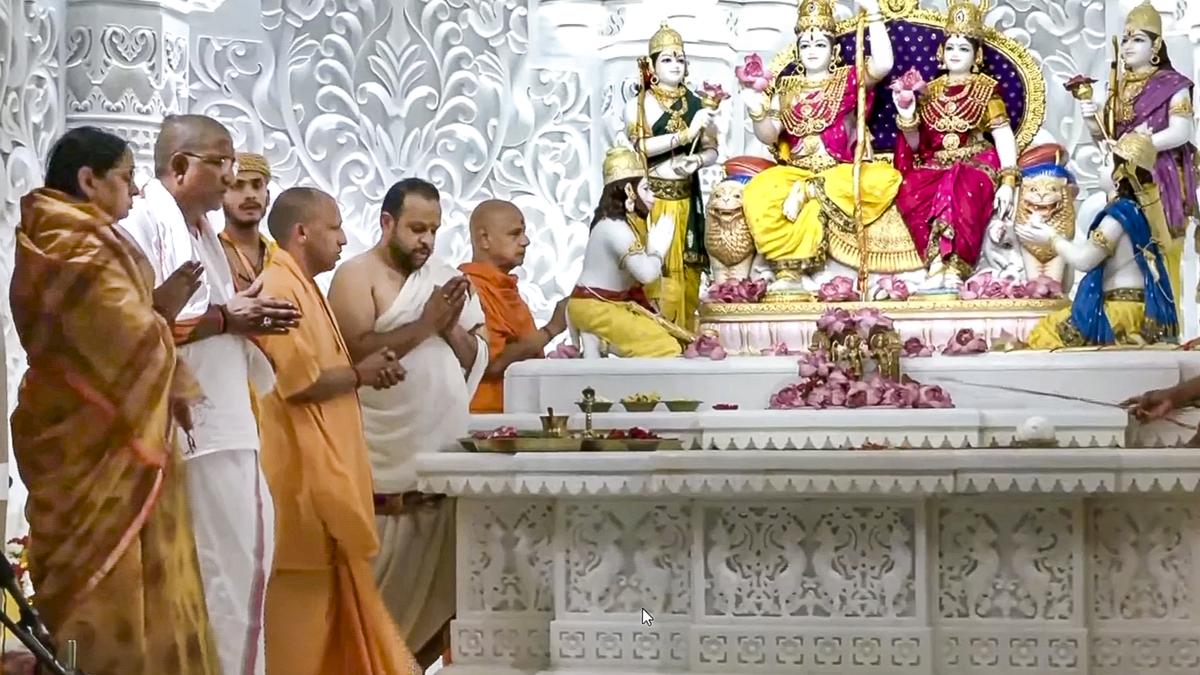The idol of Raja Ram was consecrated and the Ram Darbar inaugurated at the Ram Jamnabhoomi complex on Thursday, a major step towards completion of a grand temple that has been at the intersection of political and religious discourse for three decades.
The city was festooned and lit up as priests gathered at the first floor of the Ram temple to install the almost five-feet white marbled statue of Raja Ram, the god in his royal form, amid the chanting of hymns and elaborate rituals.
The Ram Darbar also features the idols of Sita, Lakshman, Bharat, Shatrughn and Hanuman. The day, chosen to coincide with the occasion of Ganga Dussehra, comes 16 months after the consecration of Ram Lalla, the child god, on January 22, 2024.
While Prime Minister Narendra Modi, the top government brass and a host of celebrities were present at the high octane occasion then, the event this time was quieter.

Among those conducting the ceremony were Uttar Pradesh Chief Minister Yogi Adityanath, also the head priest of the Gorakhnath Math in Gorakhpur, along with other priests. Devotees, unmindful of curbs, stood outside the temple complex, singing, dancing and chanting ‘Jai Shri Ram’ all the while.
Restrictions on vehicular movement during the inauguration ceremony by the administration and the temple trust’s decision not to issue entry passes to visitors between 9 a.m. to 3 p.m. on Thursday failed to deter the devotees, some of whom had come from as far as Nepal.
Gogan Prasad, from Nepal’s capital Kathmandu, was one such devotee.
“I have waited for this moment for long. I had been praying for more than a year for an opportunity to have darshan of Lord Ram. Now that wish will be granted,” said Mr. Prasad who had come from Nepal with a large group of devotees who also appeared overwhelmed on the occasion.
Also in the crowd was Alamin, a Muslim woman dressed in a traditional black burqa, waiting along with the others to be allowed to enter the temple. She was seen singing devotional songs, drawing much attention.
The BJP, which is in power at the Centre and in Uttar Pradesh, said in a post on X, “The second festival of Ram Mandir Pran Pratishtha concluded today in Ayodhya. A step towards Ram Rajya.” The ceremony took place during the Abhijit Muhurat, considered one of the most auspicious moments in the Hindu calendar.
The consecration of the deities began with prayers at the ‘yajna mandap’ at 6.30 a.m., followed by a ‘havan’ at 9 a.m., which lasted an hour. Thereafter, centralised rituals began simultaneously across all temple shrines, aided by visual technology like cameras and large screens, ensuring synchrony of the ceremonies.
According to the Shri Ram Janmabhoomi Teerth Kshetra Trust, among the deities consecrated were Shri Ram Darbar (central installation), Sheshavatar, Lord Shiva in the northeast (Ishan) corner, Lord Ganesha in the southeast (Agni) corner, Lord Hanuman at the southern wing, Surya (Sun God) in the southwest (Nairitya) corner, Goddess Bhagwati in the northwest (Vayavya) corner and Goddess Annapurna in the northern wing.
The temple, built in the traditional Nagara style, spans 360 feet in length, 235 feet in width, and rises 161 feet high. Spread across 2.77 acres, the three-storey structure features 392 carved pillars, 44 doors and richly sculpted depictions of Hindu deities.
Ram Temple trustee Anil Mishra told PTI that the ceremonies were performed in accordance with Vedic traditions.
“The day of Ganga Dussehra will symbolise a new beginning. It will be the moment when the fruits of centuries of penance, struggle, and faith will manifest in tangible form,” he said.
According to Hindu scriptures, Ganga Dussehra marks the day the holy river Ganga descended to Earth from Lord Shiva’s locks, moved by King Bhagirath’s penance. The day is considered highly auspicious and symbolises virtue, penance, and the collective well-being of humanity.
“This year, Ganga Dussehra will not only be sacred but also historic, as after a long struggle of 500 years, Lord Ram, known as Raja Ram, will be ceremonially installed on the first floor of the grand Ram Temple in Ayodhya,” Mahant Raghuvar Sharan, chief priest of Rasik Niwas Temple in Ayodhya, told PTI ahead of the event.

Mr. Adityanath offered prayers at the Ram Temple and visited the Hanumangarhi temple nearby.
Adding a political touch to the proceedings of the day, he said in a post on X, “This auspicious occasion is a new expression of ‘Ek Bharat-Shreshtha Bharat’. Victory to Siyavar Shri Ramachandra!” “Today, in the holy birthplace of Lord Shri Ram, Ayodhya Dham, we are getting the great fortune of becoming a witness to the programme organised for the Pran-Pratishtha of the holy idols of gods in the eight temples including Shri Ram Darbar on the first floor of Shri Ram Janmabhoomi Temple,” he said.
The inauguration of the temple in January 2024 had marked the culmination of a decades-long campaign, mostly under the Hindutva banner, to claim a disputed religious site in Ayodhya.
It was months before the Lok Sabha elections and 34 years after BJP veteran L.K. Advani’s ‘Mandir Wahin Banayenge’ speech during his Rath yatra that shaped the Ram mandir politics.
The 16th century Babri mosque at the spot, which many Hindu devotees believe is the place where Ram was born, was the centre of a simmering dispute for decades. The mosque was demolished by ‘kar sewaks’ on December 6, 1992, triggering communal riots that left hundreds dead.
After a long legal battle, the Supreme Court in 2019 ruled in favour of the construction of the temple. It also ordered allotment of a five-acre plot for building a mosque.
The scrapping of Article 370 that gave special status to Jammu and Kashmir, building a grand Ram temple in Ayodhya and the implementation of a Uniform Civil Code (UCC) have been the BJP’s poll plank for decades.
Published – June 06, 2025 01:04 am IST



